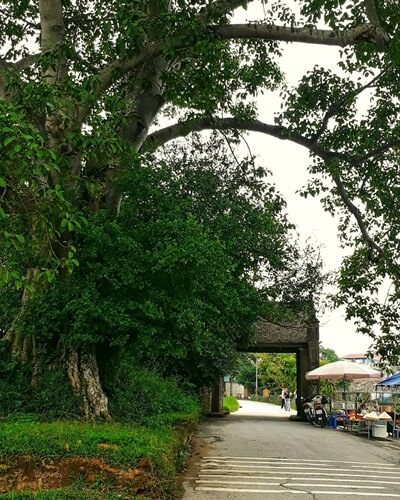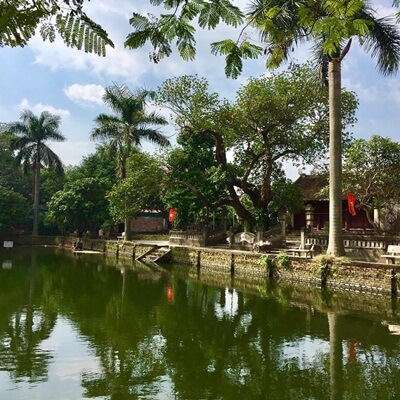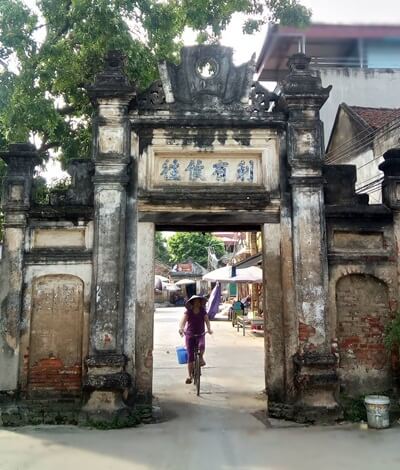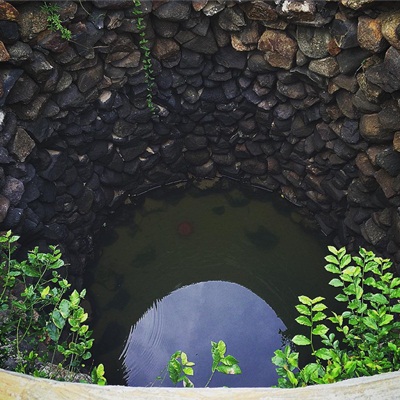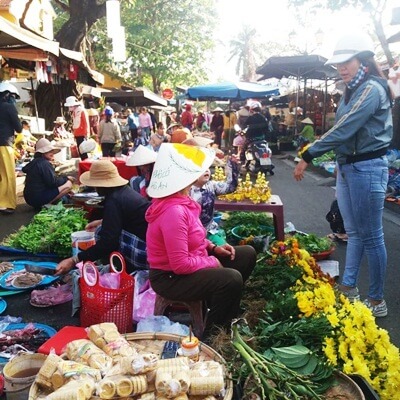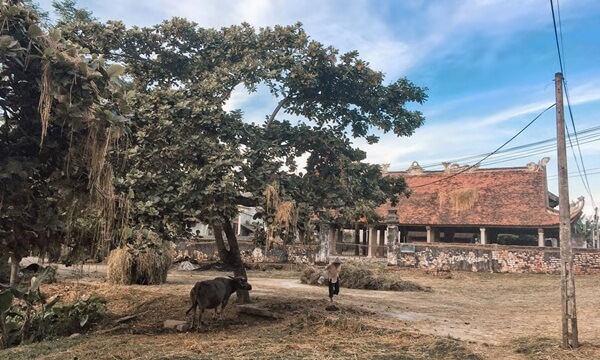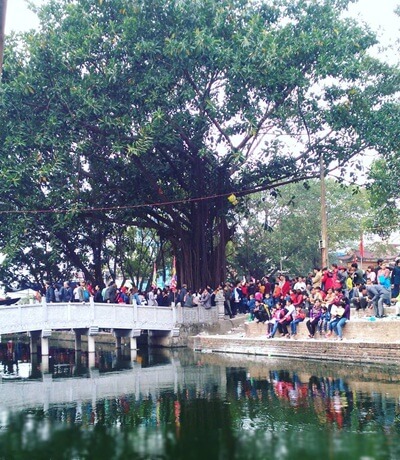The village is a community of Vietnamese residents in the countryside, which has a history of several millennia. The process of continuous development is both natural improvement, anti-foreign invasion and domination, and urbanization, but the Vietnamese villages do not lose.
The village has been still maintained, restored, re-established throughout the Red River Delta, and then developed on the central land strip and the Mekong Delta in South Vietnam.
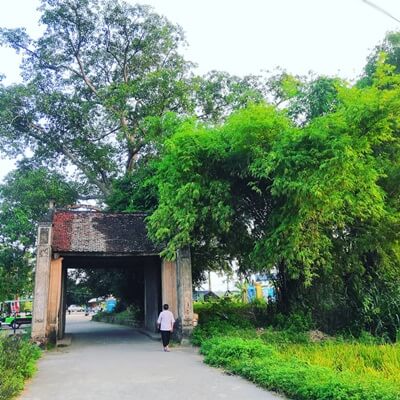
What makes the village strong and flexible like that? It is the village culture and the physical and intangible basis of the local features is the communal house, the bamboo bush, the banyan tree, the village pond, its gate…
Now we start studying the symbolic images of Vietnamese villages as below.
1. Banyan Tree
Most people consider the communal temple and banyan tree as important symbols of the traditional villages in Vietnam.
The banyan tree symbolizes longevity and vitality. It is no coincidence that the elderly, who have made a lot of achievements in a certain field, are often considered by colleagues and society as “banyan tree”, a symbol of selfless and flexible work, for the accumulation of rich knowledge.
Also with that enduring meaning, the banyan tree appears in the songs and poems as a witness of time, witnessing the changes of people, of heaven and earth, sometimes a whole life cycle.
The village banyan is also the place where villagers sit and rest after a day of hard work before going home, people often gather together. They drink Vietnamese tea, smoke pipe tobacco and tell stories, discuss and comment on life.
Banyan tree witnessed the ups and downs of all classes of the local people. Not only that, but this typical tree is also a spiritual symbol of villagers. In folk beliefs, there is the custom of worshiping the banyan tree. At the base of the plant, there is usually a small shrine to place incense bowls, lime pots to flavor the banyan tree god.
The banyan tree is a beautiful image and a majestic picture associated with the temple, pagoda, temple, wells, etc, creating a sustainable spiritual world for everyone from childhood to old age.
Also, the banyan plant symbolizes the beauty of the homeland. It adds color and sound to the peaceful village. That place attracts the flock of multicolored birds to converge, making nests and eating ripe fruits.
Thus, the banyan tree is always a beautiful symbol with most of its spiritual meanings: existing, hidden, mysterious, breathing life, and bearing spiritual elements.
Therefore, this combination has created the symbol of the banyan tree with lasting vitality in folklore, scientific poetry, and in the soul of every Vietnamese person.
The banyan tree is a beauty, a vivid image of the countryside, becoming one of the symbols in Vietnam. It contributes to making village culture more sparkling.
2. Village pond
One of the dear and deeply embedded images of every villager from childhood to old age is the image of village ponds.
The pond was also the site where many noisy activities take place, such as on the days of the Lunar New Year, the locals drained the pond to catch fishes, the others picked up the trees soaked in the mud for home repair. Many people shared a pig and pecked right on the edge of the pond, divided the meat, boiled their hearts, washed the leaves to wrap Banh Chung,… it was bustling.
The pond was also a place where villagers washed, did laundry, met, exchanged, chatted, and asked for information among village members. Besides, the pond used to be a meeting place for boys and girls in the village.
And, on the evenings and moon nights or early mornings, the pond was also associated with many unforgettable childhood memories when children gathered to play Vietnamese traditional games.
Nowadays, the village pond is in the mind of the old-age people because most of the locals do not use water from it.
3. Village gate
A village gate with old paint, wooden door, stone or clay brick frame is a familiar image of Vietnamese countrysides, typically in the Northern region.
Standing in a separate corner, far away, seemingly unrelated to the fate of the village, the village gate occupies the deepest, most silent place in the soul of the locals.
In each village in the Northern Delta, there is usually green bamboo around the settlement. The village is relatively self-contained, leaving only one or two entrances. And, this place often built a village gate to limit areas for living and open up the agricultural area. In the morning, the gate is opened, and villagers go to work, market, … Until evening, after the villagers and cattle have returned to the village, the gate is closed.
The village gate is not the only symbol of each village but exists with banyan trees and communal roofs. For those who go far, when returning to their hometown, and see the banyan tree, village gate, they seem to go to their home. It is because people in a village often treat each other like brothers in a family.
The village gate is an area where villagers come to get Asian squat down and play, is a lovely place to exchange feelings and information, and is a site to witness the departure and arrival of people.
Each village gate has its own architectural features as the focal point in the layout in harmony with the space of the village road, green bamboo groups, banyan trees, water wells, village ponds, and ripe rice fields. Its architecture is not fussy and showy but only aims to assert its position in the village space in the northern delta region…
The construction of the village gate depends on the conditions of each village. In the rich village, the gate is big with a dragon, tiger, and phoenix on it. Whether the gate is big or a small one, whether built of bricks or grafted with stones, it has to be fixed because it is the hallmark of a superficial village.
Therefore, there is no need to step deep into the village, have not yet set foot in the communal yard, but when standing in front of the village gate, strangers can also partly guess the character of the village, the character of each person. Thus, the gate must be placed in the most solemn position, so that you can immediately recognize it from a distance.
In feudal times, sometimes the village was determined depending on the size of the village gate. At that time, a village with many successful people, high-ranked mandarins, was often given the right to build a great gate by the king.
The village gate is usually a three-door gate: one big door in the middle, on the left and right sides, are two small ones. Every day villagers and strangers are only allowed to pass through those small two doors. When the village has important events such as festivals, weddings… the main door is opened.
The two sides of the gate are often attached to the opposite sentences with Chinese characters. Most of these sentences are summarized from the quintessence of the village or wishes for good things.
Thus, the village gate is a specific cultural feature and becomes a part of the village life. When going away, everyone also looks back to see the gate with the lovely feelings keeping in the heart. And, when returning to the village, the gate will be the first image to call the memories back.
4. Village well
In rural Vietnam, in the past, most villagers live in bamboo thatched houses, so very few houses have rainwater tanks. The locals mainly used public water taking from village wells.
Each village has one, two wells or more, depending on each place. The well is a convergence of living resources, attracting good things from nature for a better life.
In daily life, the villagers took well-water to use in normal activities. Thus, they came to the well very often, and that site became an important place to meet, exchange and chat for the villagers in general and the dating place for boys and girls. The water well was also a large mirror for the girls to see themselves.
Nowadays, the countryside is renovating day by day, houses are tiled and at the same time, rainwater tanks are also built. When the authorities deploy clean water for countrysides, the houses have dug wells or drilled wells. Therefore, village wells are forgotten and then leveled for construction ground.
However, there are still village wells that are participating in the daily life of people like Giang Xa village, former Ha Tay. Also, some wells today that are no longer valid for use but still preserved and protected by the locals, such as the well at Dai Phung communal house, old Ha Tay, or the To House of But Thap pagoda in Bac Ninh.
5. Village market
Referring to the characteristics of Vietnamese villages cannot help mentioning village markets. Where there are just some sellers and buyers, the markets appear.
It seems that many villages can share the same market and have different types of markets, such as Cho Hom (very early market), daily or few-day market, craft markets…
In addition to the meaning of exchange and purchase, the market is also a bustling communication place. Through the market, people can learn a lot of information not only about trading and doing business but also about all aspects of daily life. All are noisy, tumultuous, but full of villagers’ love.
People go to the market to sell unused products, where they buy the missing goods. But, some people go to the market to play, walk around and see it as a hobby. Many boys and girls go to the market to get to know and date each other. All creates the typical market culture in the countryside life.
Through visiting a market, one can know the economic, cultural, and social situation of a particular locality.
6. Communal temple
Almost every village has a communal temple. The temple is located in a central large space and the beautiful scenery of Vietnamese countryside.
The village temple is solemn and sacred, because it is almost representative and becomes a powerful symbol of the village.
In the past, all political, economic and social activities of the community took place at the communal house and that tradition was kept until the Nguyen dynasty (1802 -1945). Also, the communal house was a resting stop for the king or the great officials when traveling.
Village communal house is a gathering place, discussing work and a place to worship Thanh Hoang (the local deities). That place is to enforce village rules: tax collection, trial, punishment, activities on Tet holidays, performances, festivals…
>>> You may want to check the official holidays in Vietnam.
On Tet holidays, villagers come to the communal house to burn incense to pray and wish for good rain, wind, abundant harvests, and peaceful life.
Spring comes, the courtyard of the communal temple becomes a stage for traditional singing or wrestling, fighting cock, dancing charm …
Today, in some villages living in the Northern Delta and Central Vietnam, there are still many large monumental houses, such as Tay Dang, Trieu Khuc, Kim Lien, Dinh Bang communal houses. The communal temple is the most typical feature of the traditional villages and in particular and becomes the invaluable cultural heritage of the nation.
7. Bamboo bushes
Bamboo bushes are often used as the administrative border of a hamlet, or a village. Inside the bushes of village bamboo, there are a few hundred households to a thousand living there. Outside are the fields of rice, corn, sweet potatoes, and cassava of the rural people.
The familiar images in the village in the harvest season that we often see are the farmers going to the fields, carrying a plow on their shoulders, and the buffalo in the front.
At noon, when it is hot, on the way home from work, the farmers often tie the buffaloes to the bamboo bushes for them to stay out of the sun at the beginning of the village. And, the farmers gather around and squat or sit on the banana leaves to rest.
After each working session in the fields, it is so interesting to sit and relax under the bamboo groups, and use Vietnamese hats as fans for refreshing. Village bamboo is a place that attaches to many generations of villagers in the peaceful countryside, where there is a part of my childhood memory attached.
Many generations go away and come back. The image of bamboo bushes in the village becomes the cultural symbol in the mind of most villagers, reminding them of a tranquil area.
8. Village festivals
A vital feature of the village culture is the festival. Village festivals are traditionally religious, artistic and sports activities of the community, a highlight feature of the Vietnamese village culture.
Every year, most villages in Vietnam hold festivals for one day or more. Typically, after good harvests, the activities are incredibly happy. Village festivals are usually held at the communal house, including the ceremony and festival activities.
The festival is the part showing traditional cultural games, wrestling, playing chess, cockfighting, boat racing, martial arts, dance, and singing … All bring the sense of praying to the local deities to help the villagers get a better life.
Village festivals are usually held in the spring when heaven and earth are in harmony, nature is lush, and people’s hearts rejoice.
It can be said that the village festival is the most attractive, jubilant time with respectful and pure Vietnamese rites. All village festivals have a common desire, wishing a peaceful life and good crops.
In addition to the national festivals organized by the State, village festivals are usually organized by a village, or maybe by several ones. The countryside festival is like underground water that flows over the spiritual life of the Vietnamese people.
It can be said that the village festival is deeply communal, the peak of harmony and solidarity for a common desire for the prosperity and peace of the village.
In the festival activities, people participate in performing, composing, and enjoying after days of hard work, regardless of cowardice. Therefore, the village festivals have created a deep sympathy among members of the community, which is the consistency in the transmission of cultural values between generations.
Conclusion:
A village is a place where people are born and raised, and then after they die are buried in their own homeland. Except for special circumstances, many people never want to leave their village to go elsewhere.
Therefore, even when they have to leave the village, they always remember the village in their mind and wish to return to that site, to come back with the dear images.
And, so many symbols of Vietnamese villages ingrain in the mind of each person. The highlights are village gate, well, banyan tree, communal yard, village pond, bamboo groups …
However, today the face of the countryside in Vietnam is being renewed and changed a lot by the rural urbanization, which breaks more or less the landscape and layout that have been considered a characteristic of the culture of the rural villages.
Many people are trying to preserve national cultural beauty. These villages are no longer self-contained in bamboo rows but have integrated into urban areas. Nonetheless, there are still some valuable images mentioned above for us to see and study the unique culture of the traditional village of Vietnam.
